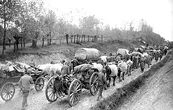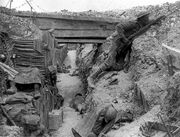![]() This alternate history related article is a stub. Please add suggestions on the talk page.
This alternate history related article is a stub. Please add suggestions on the talk page.
| World War I | |||||||
|---|---|---|---|---|---|---|---|
|
Clockwise from top: Trenches on the Western Front; a British Mark IV Tank crossing a trench; Royal Navy battleship HMS Irresistible sinking after striking a mine at the Battle of the Dardanelles; a Vickers machine gun crew with gas masks, and German Albatros D.III biplanes | |||||||
| |||||||
| Belligerents | |||||||
|
Allied (Entente) Powers
and others |
Central Powers
and others | ||||||
| Commanders | |||||||
| Allied leaders
|
Central Powers leaders
and others | ||||||
| Casualties and losses | |||||||
| Military dead:
Over 5.525.000 Civilian dead: Total dead: |
Military dead:
Over 4,386,000 Civilian dead: Total dead: | ||||||
The First World War was a military conflict centered on Europe that began in the summer of 1914. The fighting ended in late 1918. This conflict involved most of the world's great powers, assembled in two opposing alliances: the Allies (centered around the Triple Entente) and the Central Powers. More than 70 million military personnel, including 60 million Europeans, were mobilized in one of the largest wars in history. More than 15 million people were killed, making it also one of the deadliest conflicts in history. The war is also known as the World War I, the Great War, the Imperialistic War, the World War (prior to the outbreak of World War II), and the "War to End All Wars."
Background[]
In the 19th century, the major European powers had gone to great lengths to maintain a balance of power throughout Europe, resulting by 1900 in a complex network of political and military alliances throughout the continent. These had started in 1815, with the Holy Alliance between Prussia, Russia, and Austria. Then, in October 1873, German Chancellor Bismarck negotiated the League of the Three Emperors between the monarchs of Austria–Hungary, Russia and Germany. This agreement failed because Austria–Hungary and Russia could not agree over Balkan policy, leaving Germany and Austria–Hungary in an alliance formed in 1879, called the Dual Alliance. This was seen as a method of countering Russian influence in the Balkans as the Ottoman Empire continued to weaken. In 1882, this alliance was expanded to include Italy in what became the Triple Alliance.
After 1870, European conflict was averted largely due to a carefully planned network of treaties between the German Empire and the remainder of Europe orchestrated by Chancellor Bismarck. He especially worked to hold Russia at Germany's side to avoid a two-front war with France and Russia. With the ascension of Wilhelm II as German Emperor (Kaiser), Bismarck's system of alliances was gradually de-emphasized. For example, the Kaiser refused to renew the Reinsurance Treaty with Russia in 1890. Two years later the Franco-Russian Alliance was signed to counteract the force of the Triple Alliance. In 1904, the United Kingdom sealed an alliance with France, the Entente cordiale and in 1907, the United Kingdom and Russia signed the Anglo-Russian Convention. This system of interlocking bilateral agreements formed the Triple Entente.
Chronology[]
Opening hostilities[]
Confusion among the Central Powers[]
The strategy of the Central Powers suffered from miscommunication. Germany had promised to support Austria-Hungary’s invasion of Serbia, but interpretations of what this meant differed. Previously tested deployment plans had been replaced early in 1914, but never tested in exercises. Austro-Hungarian leaders believed Germany would cover its northern flank against Russia. Germany, however, envisioned Austria-Hungary directing the majority of its troops against Russia, while Germany dealt with France. This confusion forced the Austro-Hungarian Army to divideforces between the Russian and Serbian fronts.
On 9 September 1914, the Septemberprogramm, a plan which detailed Germany's specific war aims and the conditions that Germany sought to force upon the Allied Powers, was outlined by German Chancellor Theobald von Bethmann Hollweg.
African campaigns[]
Some of the first clashes of the war involved British, French and German colonial forces in Africa. On 7 August, French and British troops invaded the German protectorate of Togoland. On 10 August German forces in South-West Africa attacked South Africa; sporadic and fierce fighting continued for the remainder of the war. The German colonial forces in German East Africa, led by Colonel Paul Emil von Lettow-Vorbeck, fought aguerilla warfare campaign for the duration of World War I, surrendering only two weeks after the armistice took effect in Europe.
Serbian campaign[]

Serbian troops retreating
The Serbian army fought the Battle of Cer against the invading Austro-Hungarians, beginning on 12 August, occupying defensive positions on the south side of the Drina and Sava rivers. Over the next two weeks Austrian attacks were thrown back with heavy losses, which marked the first major Allied victory of the war and dashed Austro-Hungarian hopes of a swift victory. As a result, Austria had to keep sizeable forces on the Serbian front, weakening its efforts against Russia.
German forces in Belgium and France[]
In the east, only one Field Army defended East Prussia and when Russia attacked in this region it diverted German forces intended for the Western Front. Germany defeated Russia in a series of battles collectively known as the First Battle of Tannenberg (17 August – 2 September), but this diversion exacerbated problems of insufficient speed of advance from rail-heads not foreseen by the German General Staff. The Central Powers were thereby denied a quick victory and forced to fight a war on two fronts. The German army had fought its way into a good defensive position inside France and had permanently incapacitated 230,000 more French and British troops than it had lost itself. Despite this, communications problems and questionable command decisions cost Germany the chance of obtaining an early victory.

A British trench near the Albert-Bapaume road at Ovillers-la-Boisselle, July 1916 during the Battle of the Somme. The men are from A Company, 11th Battalion, The Cheshire Regiment.
At the outbreak of the First World War, the German army (consisting in the West of seven field armies) executed a modified version of the Schlieffen Plan, designed to quickly attack France through neutral Belgium before turning southwards to encircle the French army on the German border. The plan called for the right flank of the German advance to converge on Paris and initially, the Germans were very successful, particularly in theBattle of the Frontiers (14–24 August). By 12 September, the French with assistance from the British forces halted the German advance east of Paris at the First Battle of the Marne(5–12 September). The last days of this battle signified the end of mobile warfare in the west. The French offensive into Germany launched on August 7 with the Battle of Mulhouse had limited success.
Asia and the Pacific[]
New Zealand occupied German Samoa (later Western Samoa) on 30 August. On 11 September, the Australian Naval and Military Expeditionary Force landed on the island of Neu Pommern (later New Britain), which formed part of German New Guinea. Japan seized Germany's Micronesian colonies and, after the Battle of Tsingtao, the German coaling port of Qingdao in the Chinese Shandong peninsula. Within a few months, the Allied forces had seized all the German territories in the Pacific; only isolated commerce raiders and a few holdouts in New Guinea remained.
Early stages[]
Trench warfare begins[]
Military tactics before World War I had failed to keep pace with advances in technology. These changes resulted in the building of impressive defence systems, which out of date tactics could not break through for most of the war. Barbed wire was a significant hindrance to massed infantry advances. Artillery, vastly more lethal than in the 1870s, coupled with machine guns, made crossing open ground very difficult.
The Germans introduced poison gas; it soon became used by both sides, though it never proved decisive in winning a battle. Its effects were brutal, causing slow and painful death, and poison gas became one of the most-feared and best-remembered horrors of the war. Commanders on both sides failed to develop tactics for breaching entrenched positions without heavy casualties.
In time, however, technology began to produce new offensive weapons, such as the tank. Britain and France were its primary users; the Germans employed captured Allied tanks and small numbers of their own design.
After the First Battle of the Marne, both Entente and German forces began a series of outflanking manoeuvres, in the so-called "Race to the Sea". Britain and France soon found themselves facing entrenched German forces from Lorraine to Belgium's coast. Both sides attempted to break the stalemate using scientific and technological advances. On 22 April 1915 at the Second Battle of Ypres, the Germans (in violation of the Hague Convention) used chlorine gas for the first time on the Western Front. Algerian troops retreated when gassed and a six km (four mi) hole opened in the Allied lines that the Germans quickly exploited, taking Kitcheners' Wood. Canadian soldiers closed the breach at the Second Battle of Ypres. At the Third Battle of Ypres, Canadian and ANZAC troops took the village of Passchendaele.
On 1 July 1916, the British Army endured the bloodiest day in its history, suffering 57,470 casualties, including 19,240 dead on the first day of the Battle of the Somme. Most of the casualties occurred in the first hour of the attack. The entire Somme offensive cost the British Army almost half a million men.
[]
At the start of the war, the German Empire had cruisers scattered across the globe, some of which were subsequently used to attack Allied merchant shipping. The British Royal Navy systematically hunted them down, though not without some embarrassment from its inability to protect Allied shipping. For example, the German detached light cruiser SMS Emden, part of the East-Asia squadron stationed at Tsingtao, seized or destroyed 15 merchantmen, as well as sinking a Russian cruiser and a French destroyer. However, the bulk of the German East-Asia squadron—consisting of the armoured cruisers Scharnhorst and Gneisenau, light cruisers Nürnberg and Leipzig and two transport ships—did not have orders to raid shipping and was instead underway to Germany when it encountered elements of the British fleet. The German flotilla, along with Dresden, sank two armoured cruisers at the Battle of Coronel, but was almost destroyed at the Battle of the Falkland Islands in December 1914, with only Dresden and a few auxiliaries escaping, but at the Battle of Más a Tierra these too were destroyed or interned.
Soon after the outbreak of hostilities, Britain initiated a naval blockade of Germany. The strategy proved effective, cutting off vital military and civilian supplies, although this blockade violated generally accepted international law codified by several international agreements of the past two centuries. Britain mined international waters to prevent any ships from entering entire sections of ocean, causing danger to even neutral ships. Since there was limited response to this tactic, Germany expected a similar response to its unrestricted submarine warfare
Southern theatres[]
Faced with Russia, Austria-Hungary could spare only one-third of its army to attack Serbia. After suffering heavy losses, the Austrians briefly occupied the Serbian capital, Belgrade. A Serbian counter attack in the battle of Kolubara, however, succeeded in driving them from the country by the end of 1914. For the first ten months of 1915, Austria-Hungary used most of its military reserves to fight Italy. German and Austro-Hungarian diplomats, however, scored a coup by persuading Bulgaria to join in attacking Serbia. The Austro-Hungarian provinces of Slovenia, Croatia and Bosnia provided troops for Austria-Hungary, invading Serbia as well as fighting Russia and Italy. Montenegro allied itself with Serbia.
Eastern Front[]
1917 - 1918: The End of the War[]
Aftermath[]
| ||||||||||||||||||||

